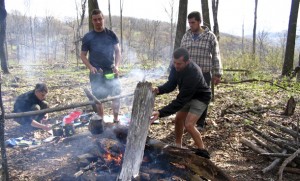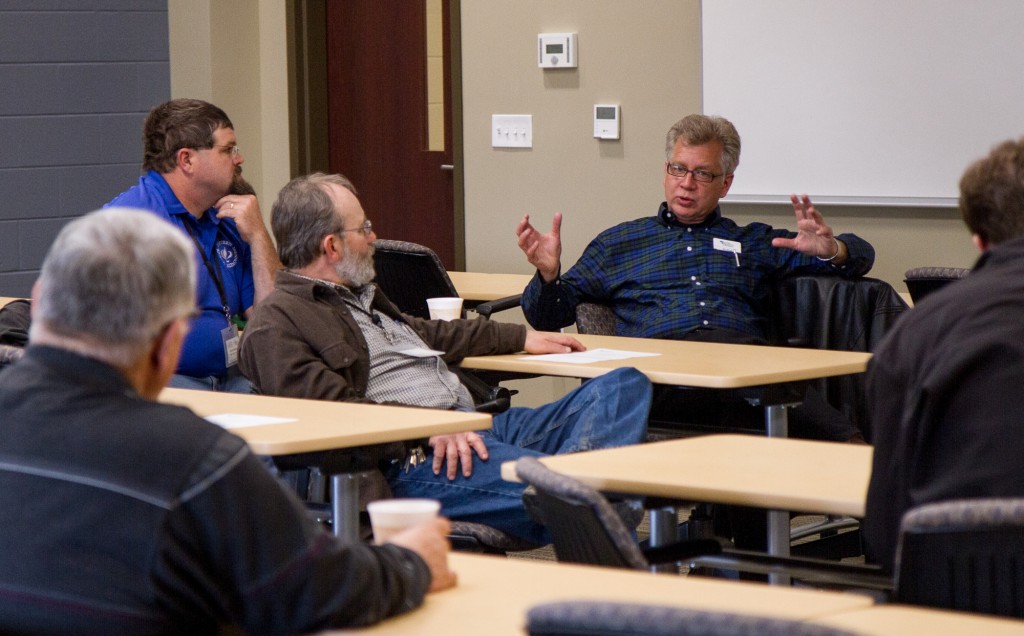About 10 years ago, Gordon Shantz, director of maintenance at Highland Retreat in Bergton, Virginia, faced a problem. The first permanent structure ever built on the property – a bathhouse with a dingy interior and crumbling structure – had become an eyesore.
Shantz had two choices: tear it down or renovate it. After consulting with, as Shantz puts it, “the one-man maintenance department of Gordie Shantz,” the decision was made.
Under his direction, youth group volunteers gutted the building, put on a fresh coat of paint, and turned it into a storage shed. The oldest permanent structure at Highland Retreat still stands.
This is a common problem among many camps with long histories and old buildings, Shantz realized. Maintenance teams must keep an eye on budgets and eco-friendly choices, while still being sensitive to architectural history.
Thus came the origin of a recent workshop, “New Wine in Old Wineskins,” for maintenance teams from camps in the eastern region of the Mennonite Camping Association (MCA). The informative visit to Eastern Mennonite University to learn about sustainability initiatives was facilitated by Ed Lehman, assistant physical plant director.

MCA, which was founded in 1960, is, “a clearinghouse for directing and promoting Christian camping among Anabaptist/Mennonite conferences and congregations around the United States and Canada.” Thirty-one North American camps are members, including Camp Men-O-Lan, the first Mennonite camp, located near Quakertown, Pennsylvania.
While the scale of EMU’s renovations are much larger than that required by the camps, EMU representatives, including building automation coordinator Greg Sachs ’03 and sustainability coordinator Jonathan Lantz-Trissel ’00, could provide general trends that translate to a smaller scale.
After a Powerpoint presentation highlighting significant renovation projects at Roselawn, Suter Science Center, and the two LEED-certified dormitories, participants had a brisk discussion about issues related to their specific facilities: Camp Deerpark, which first began hosting guests in 1935, in New York; Highland Retreat, dating from 1958; and the newest facility to be represented, Williamsburg Christian Retreat Center in Toano, Virginia, which started in 1984. A representative from Eastern Mennonite School also attended.
Camp Deerpark, which includes new buildings as well as some older structures that predate the current organization by several years, has a heating system fueled by a large wood stove and generators that run on overdrive during the cold northern winters, said maintenance director Sean McConaghay.
Among the valuable bits of information that Shantz gleaned from the visit is EMU’s 20 percent cost model on new projects. For example, if a new building costs $100, then renovation for an old building should only be considered if the total cost is $80 or less.
Shantz also favored EMU’s five-to-seven-year payback model, in which new equipment is expected to return the investment within a range of five to seven years.
For Shantz and others involved in the important but often overlooked job of keeping camps functioning and aesthetically attractive, the time to sit down, learn and share with other professionals was valuable – regardless of whether the discussion was about replacing a lightbulb, he said, or installing new toilets.
As is the case with some rural camps, the opportunity to acquire adjacent new property sometimes comes with old buildings – and a price tag. That is the case at Highland Retreat, which has recently been offered a nearby property at a favorable price, but with an old but solid building that may need renovation. Shantz has formed a committee to discuss potential uses, he said, adding that EMU’s sustainability initiatives could be a helpful model for Highland Retreat in this instance, and in any future construction project.
